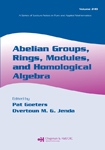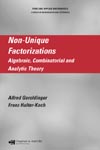Pat Goeters / Auburn University, Alabama, USA
Overtoun M.G. Jenda / Auburn University, Alabama, USA
Abelian Groups, Rings, Modules, and Homological Algebra
 Series: Lecture Notes in Pure and Applied Mathematics Volume:
249
Series: Lecture Notes in Pure and Applied Mathematics Volume:
249
ISBN: 1584885521
Publication Date: 1/27/2006
Number of Pages: 360
Reviews basic results from homological and commutative algebra
Considers Gorenstein rings from a homological point of view and
provides examples
Discusses homological algebra and demonstrates connection with
Tate homology
About the bookEbr>
In honor of Edgar Enochs and his venerable contributions to a
broad range of topics in Algebra, top researchers from around the
world gathered at Auburn University to report on their latest
work and exchange ideas on some of today's foremost research
topics. This carefully edited volume presents the refereed papers
of the participants of these talks along with contributions from
other veteran researchers who were unable to attend.
These papers reflect many of the current topics in Abelian
Groups, Commutative Algebra, Commutative Rings, Group Theory,
Homological Algebra, Lie Algebras, and Module Theory. Accessible
even to beginning mathematicians, many of these articles suggest
problems and programs for future study. This volume is an
outstanding addition to the literature and a valuable handbook
for beginning as well as seasoned researchers in Algebra.
Table of Contents
Alfred Geroldinger / Karl-Franzens Univ Graz, Austria
Franz Halter-Koch / Karl-Franzens Univ Graz, Austria
Non-Unique Factorizations: Algebraic, Combinatorial and
Analytic Theory
 Series: Pure and Applied Mathematics Volume: 278
Series: Pure and Applied Mathematics Volume: 278
ISBN: 1584885769
Publication Date: 1/13/2006
Number of Pages: 728
Provides a thorough presentation of the current state of
knowledge in the theory of non-unique factorizations
Focuses on the algebraic, combinatorial, and analytical aspects
of the theory
Offers self-contained sections on the fundamentals of v-ideal
theory, additive group theory, and analytic number theory
Presents a discussion on additive group theory, paying special
attention to recent developments and focusing on finite Abelian
groups
Focuses on the Prime Element Theorem for formations with
remainder terms and on Tauberian Theorems for arithmetically
defined Dirichlet series
From its origins in algebraic number theory, the theory of non-unique
factorizations has emerged as an independent branch of algebra
and number theory. Focused efforts over the past few decades have
wrought a great number and variety of results. However, these
remain dispersed throughout the vast literature. For the first
time, Non-Unique Factorizations: Algebraic, Combinatorial, and
Analytic Theory offers a look at the present state of the theory
in a single, unified resource.
Taking a broad look at the algebraic, combinatorial, and analytic
fundamentals, this book derives factorization results and applies
them in concrete arithmetical situations using appropriate
transfer principles. It begins with a basic introduction that can
be understood with knowledge of standard basic algebra. The
authors then move to the algebraic theory of monoids, arithmetic
theory of monoids, the structure of sets of lengths, additive
group theory, arithmetical invariants, and the arithmetic of
Krull monoids. They also provide a self-contained introduction to
abstract analytic number theory as well as a modern treatment of
W. Narkiewicz's analytic theory of non-unique factorizations.
Non-Unique Factorizations: Algebraic, Combinatorial, and Analytic
Theory builds the discussion from first principles to applied
problem solving, making it ideally suited to those not familiar
with the theory as well as those who wish to deepen their
understanding.
Table of Contents
Frances Kirwan / Balliol College, University of Oxford, UK
Jonathan Woolf / University of Liverpool, UK
An Introduction to Intersection Homology Theory, Second
Edition
 ISBN: 1584881844
ISBN: 1584881844
Publication Date: 2/7/2006
Number of Pages: 248
Provides an accessible overview that reveals the power and beauty
of intersection homology theory
Includes material on Zucker's conjecture Witt spaces, L-classes
for singular spaces, and perverse sheaves
Addresses areas of recent progress, including self-dual sheaves
and the combinatorial construction of intersection cohomology for
fans
Expands coverage of sheaf cohomology and the role of generalized
PoincarEduality.
Builds a foundation and framework for more advanced study
Now more that a quarter of a century old, intersection homology
theory has proven to be a powerful tool in the study of the
topology of singular spaces, with deep links to many other areas
of mathematics, including combinatorics, differential equations,
group representations, and number theory.
Like its predecessor, An Introduction to Intersection Homology
Theory, Second Edition introduces the power and beauty of
intersection homology, explaining the main ideas and omitting, or
merely sketching, the difficult proofs. It treats both the basics
of the subject and a wide range of applications, providing lucid
overviews of highly technical areas that make the subject
accessible and prepare readers for more advanced work in the area.
This second edition contains entirely new chapters introducing
the theory of Witt spaces, perverse sheaves, and the
combinatorial intersection cohomology of fans.
Intersection homology is a large and growing subject that touches
on many aspects of topology, geometry, and algebra. With its
clear explanations of the main ideas, this book builds the
confidence needed to tackle more specialist, technical texts and
provides a framework within which to place them.
Table of Contents
 Series: Lecture Notes in Pure and Applied Mathematics Volume:
249
Series: Lecture Notes in Pure and Applied Mathematics Volume:
249  Series: Pure and Applied Mathematics Volume: 278
Series: Pure and Applied Mathematics Volume: 278  ISBN: 1584881844
ISBN: 1584881844